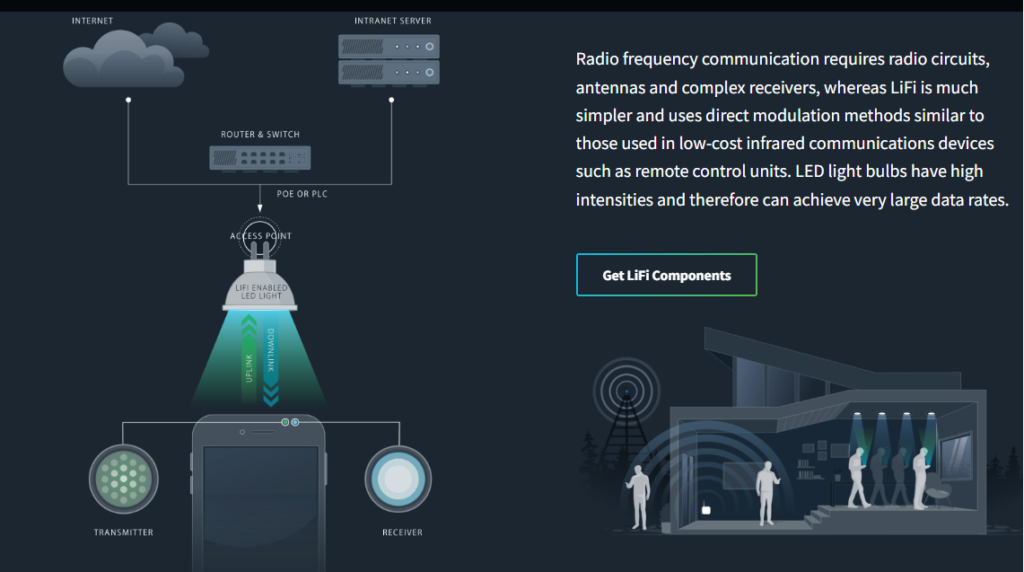Li-Fi is a light communication system that is capable of transmitting data at high speeds over the visible light, ultraviolet, and infrared spectrums. In its present state, only LED lamps can be used for the transmission of data in visible light.
The technology uses LED-based room lighting instead of radio waves to transmit data.
In terms of its end user, the technology is similar to Wi-Fi — the key technical difference being that Wi-Fi uses radio frequency to induce a voltage in an antenna to transmit data, whereas Li-Fi uses the modulation of light intensity to transmit data. Li-Fi is able to function in areas otherwise susceptible to electromagnetic interference (e.g. aircraft cabins, hospitals, or the military).
Bg-Fi is a Li-Fi system consisting of an application for a mobile device, and a simple consumer product, like an IoT (Internet of Things) device, with color sensor, microcontroller, and embedded software. Light from the mobile device display communicates to the color sensor on the consumer product, which converts the light into digital information.
LiFi companies — Signify, PureLiFi, Oledcomm and VLNComm
Trulifi by Signify has range of LiFi systems, providing two-way wireless communication that provides consistent high-speed connectivity, unique physical security and low latency for real time data streaming.
https://www.signify.com/global/innovation/trulifi
PureLifi
PureLiFi has a few products on the market: a LiFi ceiling unit to connect to an LED light fixture and LiFi-XC which is for connecting to a device via USB or as part of the hardware, providing about 43Mbps from each LiFi-enabled LED light.

Oledcomm
LiFi, high-speed internet through invisible light.
Inherent security of light, the signal using invisible near infrared light. The absence of radio waves makes it undetectable because the signal does not emit any electromagnetic signature, and it is undetectable and non-interceptable outside the room. Indeed, the optical signal does not pass through the walls of the secure room.
A software brick, the LiFiMAXController® allows the management of logs, 802.1X, VLAN, 128-bit AES key for the LiFi link, captive portal.
VLNComm
VLNComm has is Li-Fi Research and Development firm focusing on the development of bi-directional Li-Fi, it has developed fastest, most affordable and most innovative Li-Fi enabled USB adapter – LumiStick 2. The “dongle” is used for communicating between USB devices and Li-Fi enabled LED lights and will lead the way towards inter-device integration.
Visible light communications (VLC) works by switching the current to the LEDs off and on at a very high speed, beyond the human eye’s ability to notice. Technologies that allow roaming between various Li-Fi cells, also known as handover, may allow to seamlessly transition between Li-Fi. The light waves cannot penetrate walls which translates to a much shorter range, and a lower hacking potential, relative to Wi-Fi.Direct line of sight is not always necessary for Li-Fi to transmit a signal and light reflected off walls can achieve 70 Mbit/s.
Li-Fi can potentially be useful in electromagnetic sensitive areas without causing electromagnetic interference.Both Wi-Fi and Li-Fi transmit data over the electromagnetic spectrum, but whereas Wi-Fi utilizes radio waves, Li-Fi uses visible, ultraviolet, and infrared light. Researchers have reached data rates of over 224 Gbit/s, which was much faster than typical fast broadband in 2013. Li-Fi is expected to be ten times cheaper than Wi-Fi.
